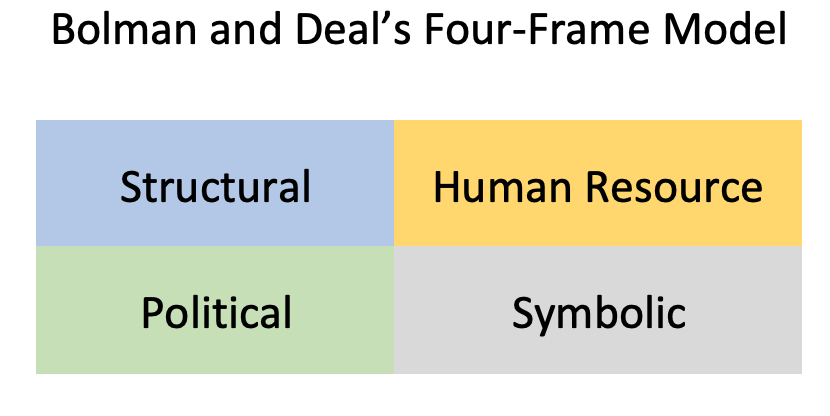
In today’s post, we will explore Bolman and Deal’s Four Frame Leadership Model and learn not only how it works, but how it can be beneficial to an organization.
The Four-Frame Model is a management concept that allows you to understand your organization on a deeper level, so you’re able to solve issues and drive the organization forward.
The model was introduced by Lee Bolman and Terrence Deal. They presented the model as a way to change an organization from the inside by giving you the tool to have an intricate understanding of the organization.
In today’s post, we’ll cover the following
- What is Bolman and Deal’s four-frame model?
- Who are Bolman and Deal?
- What are the four frames of Bolman and Deal’s model?
- Benefits of the Bolman and Deal four-frame model
- Issues associated with Bolman and Deal’s four-frame model
What is Bolman and Deal’s four-frame model?

In 1984, Lee Bolman and Terrence Deal published their Four-Frame Model.
The model described four frames or lenses through which we can see what needs to be changed within an organization.
These four frames are
- Structural,
- Human resource,
- Political
- Symbolic.
Which frame should be used in any given organization will depend entirely on the type of organization, the people involved in the change, and the degree of change they’re willing to make.
The Four-Frame Model can also help to explain the success or failure of an attempted change in retrospect through the use of the frames for interpretation.
Bolman and Deal’s Four-Frame Model facilitates significant change by providing leaders with a tool to identify issues together with the best way to tackle them.
Who are Bolman and Deal?
Lee Bolman is a scholar, author, consultant, and speaker. He’s currently a Professor of Leadership at the University of Missouri-Kansas City. Before UMKC, he was a professor for four years at Carnegie-Mellon University and for over 20 years at Harvard. He consults and lectures organizations, public agencies, universities, and schools all over the world.
Dr. Terrance Deal is a leadership expert, author, and international consultant. He founded the Terrence E. Deal Leadership Institute at the University of La Verne. He also taught leadership courses at Harvard, Stanford, Vanderbilt, and the University of South California. He’s retired now and consults many types of organizations around the world.
What are the four frames of Bolman and Deal’s model?
As mentioned earlier, the four frames in the Four-Frame Model are as follows:
1. Structural
2. Human Resource
3. Political
4. Symbolic
Let’s take a look at each of them in more detail.
1. The structural frame
The structural frame is a task-oriented frame. It focuses on strategy, setting goals that can be measured, clarifying tasks, determining responsibilities and reporting lines, agreeing on metrics and deadlines, and creating systems and procedures. In other words, the structural frame is all about the how of change.
2. The human resource frame
The human resources frame focuses on providing employees with power and the opportunity to do their job well while still addressing needs such as personal growth, human contact, and job satisfaction. In other words, the human resources frame is all about what people need.
3. The political frame
The political frame is meant to address the problem of different and often hidden agendas people may have under one organization. This is a particularly useful frame when the budget is limited and difficult choices must be made. In other words, the political frame is all about conflict resolution, building a coalition, and supporting the initiative of the leader through power-base building.
4. The symbolic frame
The symbolic frame is focused on inspiring people by providing the organization with a direction that’s distinctive and significant to its members. It’ enables a company to celebrate it’s victories, creating a motivating vision for the organization. In other words, the symbolic frame is all about responding to people’s needs for purpose, meaning, and fulfillment in their work.
Key Benefits of the Bolman and Deal four-frame model
What Bolman and Deal propose with their Four-Frame Model is that leaders should see the challenges of their organization through these lenses so they can have a complete picture.
This method then allows leaders to decide which frames to use. This is a huge benefit for leaders because it provides a no-nonsense, direct model to problem-solving and change within the organization.
The frames are meant to be used as needed, which means leaders are supposed to use one frame for a while and then change to another.
Leadership can combine frames or use them all at once if they believe that would be helpful. What this does is prevent leaders from becoming stuck in a certain view or way of acting. Instead, they’re prompted to act effectively and appropriately in the face of each individual problem or challenge. In other words, the Four-Frame Model allows leaders to be versatile.
The Four-Frames Model allows leaders to use appropriate frames of reference and therefore adjust their behavior to each challenge. This is the only way to diagnose the vital issues that are threatening the organization and ask the right questions to solve the issue and overcome the challenge.
Issues associated with Bolman and Deal’s four-frame model
There are 3 key issues associated with the four frame model.
1/ One of the issues with the Four-Frame Model is that there’s no guide or blueprint to follow when it comes to choosing the frame that will provide the right focus. This means leaders must use multiple techniques to consider the frames and choose the one that will successfully bring about the change they’re looking for.
This can introduce room for error, and if the wrong frame is chosen, it could damage or even destroy an initiative that once had potential.
2/ The model provides almost no guidance in environments that have the kind of leadership that’s more distributed. In that case, there are many agents simultaneously causing change, to the strategy becomes less clear because there’s a variety of avenues to consider.
3/ The model simplifies the different management styles into a single approach when the truth is that sometimes several approaches are required to cause change. These are the limitations of the Four-Frame Model, and they should be considered!
Summary
Bolman and Deal’s Four-Frame Model offers a good insight into how different factors can shape an organization.
It helps bring into focus that leadership often face a ‘juggling act’ in keeping key influences in balance when driving change through an organization.
We hope that you found the article useful.
As ever, we’d love your feedback; you can reach us on Twitter or by using the comments section below.
This article is part of our Management & Leadership guide.